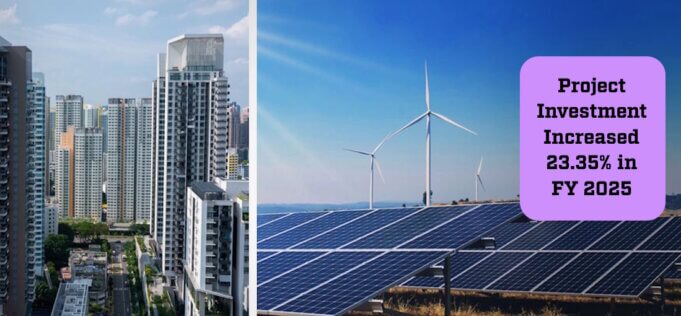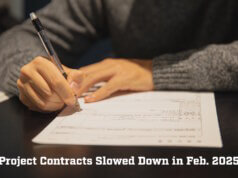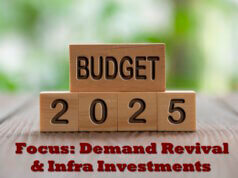As per the 98th Survey of Project Investment in India, conducted by ProjectsToday.com, during FY2025, despite the overarching challenges posed by the prolonged general elections in Q1 and global geopolitical uncertainties, the overall investment environment in India remained resilient. The country recorded a robust year-on-year growth of 25.35 percent in fresh investments, rising from Rs 35.23 lakh crore in FY2024 to Rs 44.15 lakh crore in FY2025. Alongside this increase in value, the number of new projects also rose from 10,448 to 11,720. A substantial part of this growth can be attributed to a rise in the number of mega projects in FY2025.
Mega Projects
One of the primary reasons for the overall growth in FY2025 was the sharp increase in mega projects (projects costing Rs 1,000 crore or more). At an aggregate level, the number of mega projects announced rose significantly from 531 in FY2024 to 844 in FY2025, marking an impressive increase of 59 percent in project count. Correspondingly, the total investment surged from Rs 24.71 lakh crore to Rs 32.93 lakh crore, registering a growth of 33.2 percent in investment value.
By Ownership
Government-promoted investments witnessed an increase from Rs 13.78 lakh crore in FY2024 to Rs 17.12 lakh crore in FY2025, representing a growth of 24.24 percent. In terms of project count, the rise was equally notable, with 6,945 projects initiated in FY2025 compared to 5,561 in the previous fiscal.
A disaggregated statistic shows that the Central Government investment grew sharply by 42.88 percent in value, from Rs 6.09 lakh crore to Rs 8.70 lakh crore, with project numbers rising from 1,144 to 1,681. At the macro level, the Central Government’s emphasis remained on Electricity (Rs 2.69 lakh crore), Infrastructure (Rs 4.42 lakh crore), and Manufacturing (Rs 1.19 lakh crore).
The State Governments registered a 9.47 percent modest increase in value terms with a total capex of Rs 8.41 lakh crore in FY2025 compared to Rs 7.69 lakh crore in FY2024. The number of new projects rose from 4,417 to 5,264. State Government agencies’ investment commitments were Rs 6.39 lakh crore in Infrastructure and Rs 1.31 lakh crore in the Electricity sector. Further, they accounted for all 302 Irrigation projects worth Rs 65,162 crore.
Private sector investments, including both Indian and foreign promoters, rose by 26.06 percent in value, from Rs 21.45 lakh crore in FY2024 to Rs 27.04 lakh crore in FY2025. However, the number of projects slightly declined from 4,887 to 4,775, suggesting the presence of more large projects.
Indian private promoters led the momentum by announcing a total investment of Rs 24.20 lakh crore across 4,507 projects—up by 32.90 percent in value terms. In contrast, foreign private investment saw a contraction, falling by 12.46 percent to Rs 2.83 lakh crore, despite a marginal increase in the number of projects from 257 to 268.
The Manufacturing sector continued to account for a significant portion of private investments (Rs 9.68 lakh crore), followed closely by the Electricity sector (Rs 10.16 lakh crore). A major highlight is the increasing share of private investment in Infrastructure, which attracted Rs 6.77 lakh crore across 2,805 projects.
By Sector
Manufacturing
Manufacturing, one of the important sectors in terms of employment creation and exports, witnessed a contraction in its share of total investment, falling from 33.79 percent to 24.67 percent, and in project count from 1,880 to 1,391. In the same line, total fresh investments fell from Rs 11.90 lakh crore to Rs 10.89 lakh crore, a decline of 8.5 percent. Among the major sectors, Manufacturing was the only one to register a fall in investment on a Y-o-Y basis.
Within this sector, sub-sectors such as Electronics (-41.7 percent) and Automobiles (-12.1 percent) saw Y-o-Y declines. On the other hand, traditional industries like Refineries (Rs 3,610 crore to Rs 1,00,876 crore), Aluminium (Rs 4,043 crore to Rs 94,642 crore), and Electrical machinery (Rs 27,198 crore to Rs 64,359 crore) registered year-on-year growth.
Infrastructure
Infrastructure, the largest recipient of investment in absolute terms, sustained momentum. Investment increased by 22.2 percent from Rs 14.40 lakh crore to Rs 17.60 lakh crore, and the project count rose from 7,830 to 8,929, a net addition of 1,099 projects.
Within this sector, fresh investment in the Roadways increased from Rs 4.48 lakh crore to Rs 4.87 lakh crore. Ports saw a substantial rise from Rs 33,506 crore to Rs 57,975 crore (73 percent growth), and in the Power distribution, investment quadrupled from Rs 43,969 crore to Rs 1.93 lakh crore, reflecting network expansion and grid modernisation efforts. However, sectors like Railways (–50 percent) and Water Supply and Treatment infrastructure produced uneven sub-sectoral performance.
The Construction sector (inclusive of Real Estate, Commercial Complexes, and Industrial Parks) posted a robust rise of 28.9 percent, from Rs 4.76 lakh crore to Rs 6.13 lakh crore, driven by growth in Real Estate (Rs 3.24 lakh crore to Rs 4.96 lakh crore, +53.1 percent) and Increase in Commercial Complexes, albeit at a slower pace (15.2 percent). Industrial parks saw a contraction of 44.8 percent, which may be partially due to the slow investment seen in the Manufacturing sector.
Electricity
The Electricity sector overtook the Manufacturing sector in terms of new investments in FY2025. In all the sector, the sector saw fresh investment nearly double, from Rs 8.07 lakh crore in FY2024 to Rs 14.17 lakh crore in FY2025, a rise of 75.5 percent. The number of new projects more than doubled, from 401 to 968. Within this sector, fresh investments surged impressively in the Solar and Wind Power sectors. In Solar power, new investment increased from Rs 1.82 lakh crore (218 projects) to Rs 6.63 lakh crore (669 projects), a 264 percent increase. A similar trend was seen in the Wind power sector, where investment rose substantially, from Rs 58,799 crore to Rs 2.74 lakh crore, up by 367 percent, supported by 190 new projects compared to 55 in FY2024.
Though fresh investment halved in the Hydel Power sector, from Rs 4.76 lakh crore in FY2024 to Rs 2.38 lakh crore in FY2025, the 57 Hydel Power projects intend to add 40,000 MW of new generation capacity.
Mining
Mining investments grew from Rs 52,689 crore in FY2024 to Rs 84,108 crore in FY2025, an increase of 59.6 percent, while the number of projects increased from 99 to 130. Mega projects by Coal Gas India, Jindal Power, and GMDC in the Coal sector and by Vedanta and ONGC in the Oil and Gas sector helped the Mining sector to record an impressive growth of 59.63 percent in FY2025.
Irrigation
Although irrigation accounts for a small portion of the total investment, the sector saw a notable expansion in FY2025. Investment announcements more than doubled from Rs 31,781 crore to Rs 65,163 crore, reflecting a 105 percent rise. The number of projects rose from 238 to 302. Fresh investment intentions taken up by the Madhya Pradesh, Rajasthan, and Telangana state governments helped the sector to post a healthy investment growth.
By States
The analysis of fresh investment across the top ten Indian states during FY2025, as compared to FY2024, reveals significant shifts in capital allocation, sectoral focus, and relative rankings among states.
Maharashtra continued to remain the top state in terms of total fresh investment in FY2025, although both its share and number of projects declined slightly. This may be attributed to the month-long state election held in November 2024. The state attracted Rs 7.94 lakh crore across 2,124 projects, as against Rs 7.96 lakh crore from 2,451 projects in FY2024. The reduction in its share from 22.61 percent to 17.98 percent suggests that while it retained a dominant position in absolute terms, other states gained more rapidly.
Gujarat also maintained its second position, recording a growth in investment from Rs 4.30 lakh crore to Rs 5.14 lakh crore. The number of new projects rose modestly from 1,092 to 1,137. The state benefitted from two large-scale Roadway projects, a Hydrogen and Gases project by Larsen & Toubro, and a Port project by the Deendayal Port Authority. The state managed to attract both public and private sector capital during FY2025.
Rajasthan emerged as a major gainer during FY2025, moving up significantly from the eighth position in FY2024 to third place. Its total investment surged more than fourfold, from Rs 1.10 lakh crore to Rs 4.65 lakh crore, while the number of new projects increased from 501 to 873. Eight mega highway projects worth Rs 57,000 crore of Public Works Department, Rajasthan, and a Rs 11,000 crore Solar Power project of ACME Cleantech Solutions helped the state to scale up its rank in terms of total capex.
Karnataka also reported steady progress, with its investment growing from Rs 2.91 lakh crore to Rs 3.92 lakh crore and project count increasing from 679 to 1,058. Notable contributor to this growth was a Rs 23,000 crore Bengaluru Circular Rail project by South Western Railway.
Andhra Pradesh made impressive strides, nearly tripling its investment inflow from Rs 1.05 lakh crore to Rs 3.07 lakh crore. This surge was largely driven by two landmark industrial projects: Bharat Petroleum’s proposed refinery with an investment of Rs 95,000 crore and ArcelorMittal Nippon Steel’s steel plant valued at Rs 70,000 crore. The number of new projects in the state rose from 270 to 351.
Odisha, which had ranked third in FY2024, registered a decline in both rank and investment value in FY2025. Its investment dropped from Rs 3.23 lakh crore to Rs 2.83 lakh crore, and the project count was reduced from 461 to 375. In Madhya Pradesh, project investment more than doubled from Rs 1.01 lakh crore in FY2024 to Rs 2.22 lakh crore in FY2025, while the number of new projects remained at the same level. The major contributor to this increase was Torrent Power’s Rs 43,000 crore spread across Thermal, Hydel, and Solar/Wind power projects.
Uttar Pradesh registered a modest increase in investment from Rs 2.03 lakh crore to Rs 2.10 lakh crore, while the number of projects rose from 742 to 951. Although the total investment did not grow significantly, the increase in project count indicates a rise in small to mid-sized investments.
Telangana’s performance during the year was relatively subdued. Investment declined from Rs 2.03 lakh crore to Rs 1.75 lakh crore, although the number of projects rose from 453 to 586. This suggests a shift towards smaller projects with lower capital intensity. The decline in average project value led to a fall in Telangana’s overall rank and share of national investment.
Chhattisgarh, which was not part of the top ten list in FY2024, entered the list in FY2025 with Rs 1.63 lakh crore in fresh investments across 218 projects. The rise was led primarily by NTPC Green Energy’s proposed nuclear-based power plant, valued at Rs 80,000 crore. This single project catapulted the state into the tenth position, displacing Tamil Nadu, which had been part of the top ten in the previous year.
Outlook for FY2026
The strong growth seen in overall new capex commitments during FY2025 indicates a revival in the Indian capex cycle. The growth has come over a 4.5 percent decline recorded in FY2024. However, the fall in fresh investment commitments in the Manufacturing sector is a matter to worry. This indicates that at the ground level, some uneasiness persists among the private promoters when it comes to new capacity building.
Higher capacity utilisation reported by the companies, the revival seen in overall demand for goods, robust agriculture production, and reduction in inflation augur well for project investment. In addition, the recent decision of the RBI to reduce the repo rate to 6.0 percent is expected to increase demand in the Construction sector and reduce the borrowing costs for project financing.
On the flip side, caution is warranted due to persistent geopolitical unrest and threats of trade protectionism, especially from the USA. This would make project promoters go slow on their immediate investment plans.
While the outlook for project investment looks a bit hazy in the first two quarters, Projects Today expects things to turn better in the second part of the current fiscal FY2026.
Amid ongoing uncertainty, the government should persist with infrastructure investments in the social and transport sectors while also enhancing incentives for the private sector to sustain and stimulate investment activity.
Cover photo: www.freepik.com











